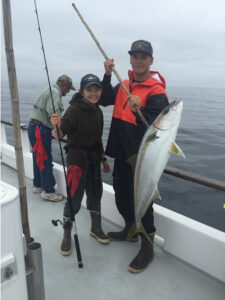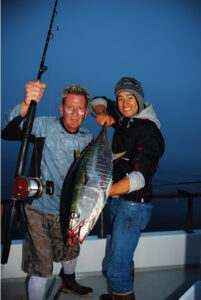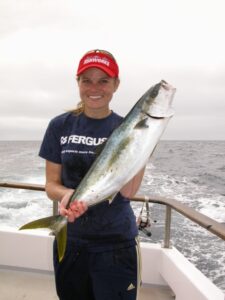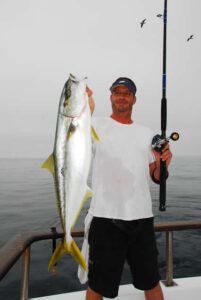 How do I get my son or daughter started in offshore fishing?
How do I get my son or daughter started in offshore fishing?
One of the questions I get when I’m traveling around doing seminars is, “When and how do I get my son or daughter started in fishing and eventually getting them out on the long-range boats?” Many people want to share their on-the-water experiences with their children or grandchildren and have great intentions, but they don’t know what steps to take in the process.
Probably the worst thing they can do is to jump them right onto an overnight boat in the peak of the season with 30 hard-core fishermen who lose sight of everything around them, including children, when the bite really goes off. You need to provide an environment for success and fun for fishing with kids to get them excited.
I have seen kids ruined for a long period of time because their first offshore experience did not go well. They had no idea what to expect from the trip, how to handle moving around the boat, whether or not they would get seasick, an inability to squeeze into the frenzied bait tank for bait let alone getting a spot on the rail during the bite. We don’t want this to be our child’s first taste of offshore fishing. You may never get them out there again!
If you want to involve your children or grandchildren in the sport start them early and start them young. A good age to start is six or seven years old. They have enough strength and coordination to handle small freshwater species.
However, their attention span is short so the fishing needs to be very good if not wide open. I think you start with fishing for bluegill or crappie. Once the fish are located you can catch hundreds of them and the kids just go nuts. It’s critical that they have fun and success when they start fishing.
 You can fish from the bank, dock, or boat but the key is to let the kids have fun and do what they want to do. They may fish for 10, 20, or 30 minutes and then want to go hike around, ride the boat or start throwing rocks.
You can fish from the bank, dock, or boat but the key is to let the kids have fun and do what they want to do. They may fish for 10, 20, or 30 minutes and then want to go hike around, ride the boat or start throwing rocks.
Don’t force them to stay fishing! Let them guide your activities even if it means wasting all the bait you just bought. Let them lead and do what they want. It will be much easier to get them out next time if dad or grandpa isn’t forcing them to stick with it because that’s what you want to do.
Once you have shown them that they can have fun and success fishing move them up into some of the bigger and tougher freshwater species like Trout and Largemouth Bass.
By starting them in fresh water, giving them opportunities for success, and allowing them to set their own pace you have laid an excellent foundation for moving them to ocean fishing.
Here is where I would, again, start them slowly. That could mean pier or surf fishing with kids. At this point, you could even move them directly to the half-day boats. It’s the half-day boats that are the real preschool for the entire sport fishing industry. They learn species identification, and how to tie their knots and they will learn how to move and interact with the other people on the boat.
On half-day boats during the summer you will get lots of bites, great practice on setting the hook and they have a good time. Additionally, the tackle on these types of trips is lighter and easier to handle for kids. It’s 12 to 15-pound gear and even spinning rods and reels.
 This length of the trip will also let you see how they can handle the swell of the ocean and whether or not they will be prone to motion sickness. If they have a problem you’re not on the water for 24 hours with your child in agony.
This length of the trip will also let you see how they can handle the swell of the ocean and whether or not they will be prone to motion sickness. If they have a problem you’re not on the water for 24 hours with your child in agony.
Another factor that can’t be overlooked is practicing through each step in the learning curve. Take your child to the park or backyard and get them the best beginner fishing rod they will be using. When you expose them to new gear make sure the first time they’ll be using it isn’t on the water. Give them some confidence in casting and you may find that they enjoy that more than catching fish at times.
Teach them a couple of simple knots at home, like the Palomar and San Diego Knot. Soon they will take pride in trying their own rigs. Remember, let them set the agenda when they’re young. They will outgrow the short attention phase and realize that fishing is much better when you’re catching fish.
Remember that your child may not be like you in every way. You may have no problem with motion but they might and the opposite can also be true. Play it safe, and don’t risk their fishing future to seasickness. Once they have a few good experiences on half-day boats move them up to ¾ day boats and then full 5:00 am to 5:00 pm operations.
Once they have gained these experiences they should be ready to start the learning process for the overnight fleet. Here you will want to make sure you pick a kid friendly fishing charter. Talk to the skipper, and explain the situation before you start the trip. Most of the crew is more than eager to help youngsters get their fair share of Tuna, Albacore, and Yellowtail.
 You will be amazed at how attentive the crew members will be in helping you with your child. In most cases, they can build an inseparable bond with the crew. On the Prowler, we make it a point to do everything in our power to give your child a good experience. However, remember that no one can replace dad or grandpa. When the bite heats up the crew will be very busy and you may want to consider putting your rod down and just helping your son, daughter, or grandchild slam into a 30-pound Yellowfin. That’s what it’s all about! It will be the blessing of a lifetime to watch the joy on your child’s face when you accomplish this goal together.
You will be amazed at how attentive the crew members will be in helping you with your child. In most cases, they can build an inseparable bond with the crew. On the Prowler, we make it a point to do everything in our power to give your child a good experience. However, remember that no one can replace dad or grandpa. When the bite heats up the crew will be very busy and you may want to consider putting your rod down and just helping your son, daughter, or grandchild slam into a 30-pound Yellowfin. That’s what it’s all about! It will be the blessing of a lifetime to watch the joy on your child’s face when you accomplish this goal together.
Another important factor is that it’s never too late to start. If your kids are older you may be able to move them along faster because of their maturity level. The idea here is to at least try the sport to see if they have an interest.
Follow these simple steps in the learning progression and hopefully, you will share a lifelong family involvement in angling.
